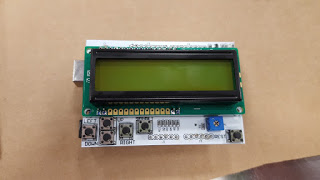LCD Button Shield V2 for Arduino by Sparkfun

TheLCD Button Shield from Sparkfun Electronics provides a 16x2 LCD screens along with a keypad consisting of 5 keys — select, up, right, down and left. With this shield you will be able to move through menus and make selections straight from one board attached to your Arduino without requiring a massive tower of shields.
The LCD Button Shield V2 works perfectly in 4-bit mode with the “LiquidCrystal” library found in the Arduino IDE.
NOTE: The pin hook up used by this shield is different from the samples in the library.
**The circuit used in Arduino library is usually wired as:**
\* LCD RS pin to digital pin 12
\* LCD Enable pin to digital pin 11
\* LCD D4 pin to digital pin 5
\* LCD D5 pin to digital pin 4
\* LCD D6 pin to digital pin 3
\* LCD D7 pin to digital pin 2
\* LCD R/W pin to ground
\* 10K resistor:
\* ends to +5V and ground
\* wiper to LCD VO pin (pin 3)
** The circuit on the shield is wired as:**
\* LCD RS pin to digital pin 8
\* LCD Enable pin to digital pin 9
\* LCD D4 pin to digital pin 4
\* LCD D5 pin to digital pin 5
\* LCD D6 pin to digital pin 6
\* LCD D7 pin to digital pin 7
\* LCD R/W pin to ground
\* 10K resistor:
\* ends to +5V and ground
\* wiper to LCD VO pin (pin 3)
The keypad consisting of 5 keys are arranged in a voltage ladder connected to A0. Each key press produces a unique value ranging from 0 to 1023. Pressing multiple keys together will generate unique values as well. When I wrote the demo program to test the shield I would use the serial monitor to see the analogue values read for each key then I adjusted my code to accept values ranging within +- 10 of the value read.
Here is a short video of the shield with the demo code below:
/*
LiquidCrystal Using Sparkfun LCD Button shield
https://www.sparkfun.com/products/13293
NOTE: This uses different hook up than what the examples in the arduino library use. see The circuit:
* LCD RS pin to digital pin 12 (8 for shield)
* LCD Enable pin to digital pin 11 (9 for shield)
* LCD D4 pin to digital pin 5 (D4)
* LCD D5 pin to digital pin 4 (D5 for shield)
* LCD D6 pin to digital pin 3 (D6 for shield)
* LCD D7 pin to digital pin 2 (D7 for shield)
* LCD R/W pin to ground
* 10K resistor:
* ends to +5V and ground
* wiper to LCD VO pin (pin 3)
*/
// include the library code:
#include <LiquidCrystal.h>
// initialize the library with the numbers of the interface pins
// for the sparkfun shield
LiquidCrystal lcd(8, 9, 4, 5, 6, 7);
void setup()
{
// set up the LCD's number of columns and rows:
lcd.begin(16, 2);
Serial.begin(9600); //for debugging
}
char* buttons[] = {"Left", "Up", "Down", "Right", "Select", "Undefined"};
#define LEFT_BUTTON 0
#define UP_BUTTON 1
#define DN_BUTTON 2
#define RIGHT_BUTTON 3
#define SEL_BUTTON 4
#define UNDEFINED 5
int buttonindex;
void loop()
{
int buttonValue = 1023;
lcd.clear();
lcd.print("Press Any Button");
while (buttonValue > 1015)
{
buttonValue = analogRead(A0);
Serial.println(buttonValue);
}
if (buttonValue > 845 && buttonValue < 865) // left button
{
buttonindex = LEFT_BUTTON;
}
else if (buttonValue > 915 && buttonValue < 949) // UP button
{
buttonindex = UP_BUTTON;
}
else if (buttonValue > 895 && buttonValue < 910) // down button
{
buttonindex = DN_BUTTON;
}
else if (buttonValue > 810 && buttonValue < 820) // right button
{
buttonindex = RIGHT_BUTTON;
}
else if (buttonValue > 605 && buttonValue < 620) // select button
{
buttonindex = SEL_BUTTON;
}
else buttonindex = UNDEFINED;
lcd.clear();
lcd.print(buttons[buttonindex]);
lcd.print(" pressed");
// wait for key to be releasted
while (buttonValue < 1000)
{
buttonValue = analogRead(A0);
}; // sit in this loop till key unpressed
}
Click Here to pick up one of these shields for your next project
David Riewe
Published
Wed 30 December 2015
Comments
comments powered by Disqus